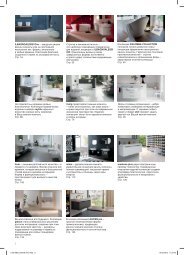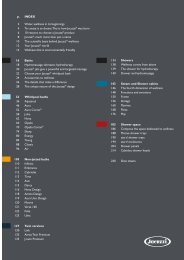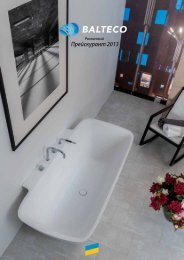Create successful ePaper yourself
Turn your PDF publications into a flip-book with our unique Google optimized e-Paper software.
Recommendations relating to installation and maintenance of<br />
ceramiche <strong>Marca</strong> <strong>Corona</strong><br />
BEFoRE inSTAllATion<br />
As the professional figure responsible for creating the tiling and the first to “see” and “handle” the tiles, the person laying the tiles must:<br />
• Notify the client and designer of any obvious defects (quality, tone, etc.) in the tiles;<br />
• Follow a tiling plan which specifies a particular installation technique (closed, minimal or open joint, laying in parallel or diagonal, continuous or staggered joints, etc.); before proceeding<br />
with installation, it is recommended that the installer shows the final customer a representative sample of the tiles to be installed (by laying them down in the intended installation pattern<br />
without using any grout) and asks for verbal, or, better still, written approval.<br />
The mellow patina giving the tile surface different hues is a characteristic feature of some ceramic products.<br />
Ceramiche <strong>Marca</strong> <strong>Corona</strong> recommends an installation pattern offsetting the planks at the most of the:<br />
- 20cm/ 8” for rectangular sizes with 60 cm/24” side (6”x24”, 12”x24”, etc);<br />
- 30cm/12” for rectangular sizes with 90 cm/36” side (6”x36” R, 9”x36” R, 18”x36” R, etc);<br />
- and leave at least joints of at 2,0mm in width when laying a single sized and obligatory 2,0/3,0mm when laying a combination of the both sizes.<br />
• For outdoor floor recommends open joint installation (at least 3,0mm).<br />
20cm / 8” 30cm / 12”<br />
dURinG inSTAllATion<br />
Before starting the installation process, make sure the laying surface is well cured, flat and completely clean.<br />
To obtain the best chromatic effects, alternate tiles from different boxes.<br />
During installation, the installer must point out the presence of any imperfections on the tiled floor (presence of steps or uneven levels between adjacent tiles etc.) and the installer must<br />
ask for official written authorisation to proceed with the work from the final customer or from the foreman responsible for the works.<br />
The final customer must also provide an assurance that the lighting and micro-climatic conditions at the workplace are sufficiently good to allow the installer to lay the tiles correctly, and<br />
the installer must check the ceramic materials and the installation procedure, as stated above.<br />
Between the installation and the consignment to the final customer, the ceramic tiling must:<br />
• Be kept clean and free from any cement, sand or other dirt residue which can cause stains and/or mechanical abrasion to the surface;<br />
• Be protected from any damage caused by the presence of other operators (painters, electricians, carpenters, etc.).<br />
wARninG<br />
ONCE ThE CERAMIC TILES hAVE BEEN INSTALLED, CERAMIChE MARCA CORONA:<br />
• DO NOT ACCEPT RESPONSIBILITY FOR COMPLAINTS RELATING TO MANIFEST FAULTS OF SHADE AND QUALITY;<br />
• WILL NOT BE LIABLE FOR THE QUALITY OF THE TILED SURFACE BUT ONLY FOR THE QUALITY CHARACTERISTICS OF THE SUPPLIED MATERIAL.<br />
ON COMPLETION OF ThE INSTALLATION IT IS ADVISABLE TO kEEP SOME SPARE TILES ASIDE, ShOULD SOME TILES NEED TO BE REPLACED OR AS A REPRESENTATIVE SAMPLE OF ThE<br />
MATERIAL IN CASE OF COMPLAINTS.<br />
Recommended adhesives<br />
The use of an appropriate adhesive is essential for a correct installation. For the installation of ceramic tiles you should follow the laying instructions provided by leading adhesives<br />
manufacturers.<br />
you should choose the most suitable adhesive on the basis of the following factors:<br />
• type of bed;<br />
• type and size of tile;<br />
• use of tiled surface (floor/wall; indoor/outdoor);<br />
• weather conditions at the time of laying;<br />
• waiting time before the ceramic surface can be used.<br />
249

















